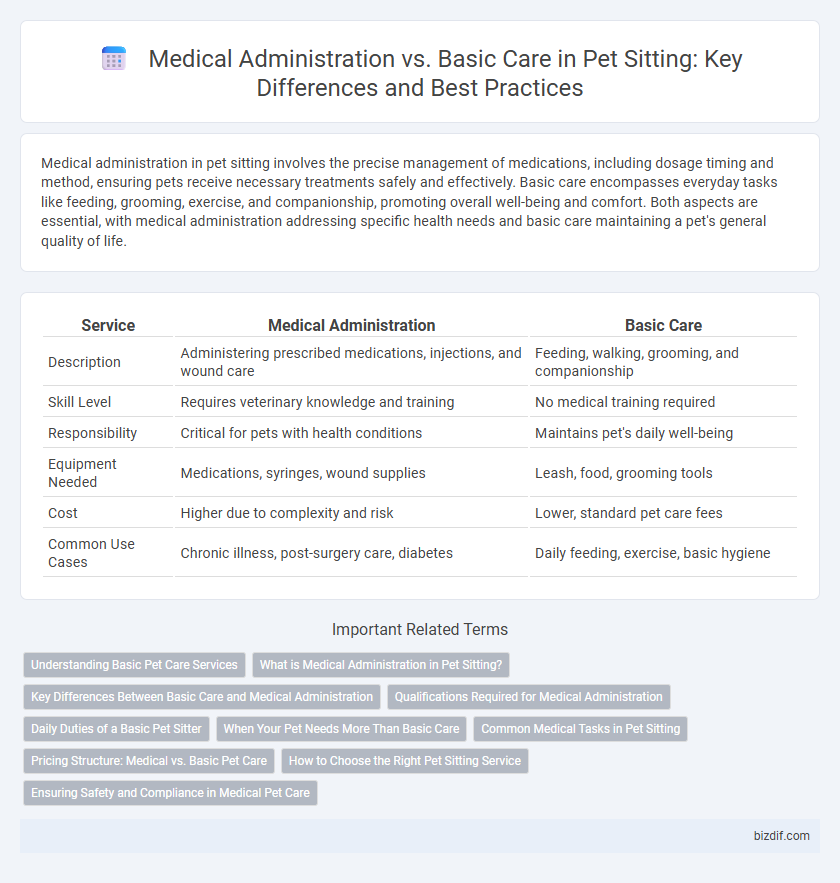Medical administration in pet sitting involves the precise management of medications, including dosage timing and method, ensuring pets receive necessary treatments safely and effectively. Basic care encompasses everyday tasks like feeding, grooming, exercise, and companionship, promoting overall well-being and comfort. Both aspects are essential, with medical administration addressing specific health needs and basic care maintaining a pet's general quality of life.
Table of Comparison
| Service | Medical Administration | Basic Care |
|---|---|---|
| Description | Administering prescribed medications, injections, and wound care | Feeding, walking, grooming, and companionship |
| Skill Level | Requires veterinary knowledge and training | No medical training required |
| Responsibility | Critical for pets with health conditions | Maintains pet's daily well-being |
| Equipment Needed | Medications, syringes, wound supplies | Leash, food, grooming tools |
| Cost | Higher due to complexity and risk | Lower, standard pet care fees |
| Common Use Cases | Chronic illness, post-surgery care, diabetes | Daily feeding, exercise, basic hygiene |
Understanding Basic Pet Care Services
Basic pet care services include feeding, grooming, exercise, and companionship to maintain a pet's daily well-being. Medical administration involves tasks such as administering medications, monitoring health conditions, and managing treatments prescribed by a veterinarian. Understanding these distinctions ensures pet sitters provide appropriate care tailored to each pet's health requirements.
What is Medical Administration in Pet Sitting?
Medical administration in pet sitting involves the precise handling and delivery of prescribed medications, including oral pills, topical treatments, injections, and eye or ear drops, ensuring pets receive proper health care outside of a veterinary clinic. This service requires pet sitters to understand medication schedules, dosages, and any potential side effects to monitor pets accurately and maintain veterinary standards. Unlike basic care, which includes feeding, walking, and general companionship, medical administration directly supports pets with chronic conditions or recovery needs that require expert attention.
Key Differences Between Basic Care and Medical Administration
Basic care in pet sitting involves routine tasks like feeding, grooming, and exercise to maintain general well-being, while medical administration requires precise handling of medications, injections, and monitoring of health conditions. Trained pet sitters performing medical administration must understand dosages, potential side effects, and emergency procedures, distinguishing it from the less specialized tasks in basic care. Accurate medical administration enhances recovery and health management, making it critical for pets with chronic illnesses or post-surgery needs.
Qualifications Required for Medical Administration
Medical administration in pet sitting requires specific qualifications such as veterinary technician certification or specialized training in medication management to ensure accurate dosing and handling of prescriptions. Basic care involves routine tasks like feeding and walking, which do not require formal medical credentials but emphasize trustworthiness and reliability. Proper medical administration demands adherence to strict protocols and often supervision by a licensed veterinarian to safeguard pet health.
Daily Duties of a Basic Pet Sitter
Basic pet sitters focus on daily duties such as feeding, watering, walking, and providing companionship to pets, ensuring their comfort and emotional well-being. Unlike medical administration, which involves tasks like administering medications, injections, or managing chronic conditions, basic care prioritizes routine attention and maintaining a safe environment. This essential role supports pet owners by ensuring pets' physical and behavioral needs are met consistently.
When Your Pet Needs More Than Basic Care
Medical administration involves tasks such as administering prescription medications, monitoring chronic conditions, and providing wound care, which require specialized knowledge and training. Basic care includes feeding, watering, walking, and cleaning up after pets, essential for daily wellbeing but insufficient during illness or injury. When your pet needs more than basic care, professional pet sitters trained in medical administration ensure proper treatment and comfort, preventing complications and promoting faster recovery.
Common Medical Tasks in Pet Sitting
Common medical tasks in pet sitting include administering prescribed medications, monitoring vital signs, and managing wound care to ensure proper healing. Basic care involves feeding, grooming, and providing exercise, while medical administration requires specialized knowledge of dosage, timing, and potential side effects. Understanding these distinctions helps pet sitters deliver safe and effective care tailored to pets' specific health needs.
Pricing Structure: Medical vs. Basic Pet Care
Medical pet care pricing typically involves higher fees due to specialized skills, medication handling, and veterinary coordination, often averaging $25-$50 per visit. Basic pet care, covering feeding, walking, and companionship, generally ranges from $15-$30 per session depending on duration and frequency. Transparent pricing structures help pet owners budget effectively while ensuring their pets receive appropriate levels of care.
How to Choose the Right Pet Sitting Service
Choosing the right pet sitting service involves evaluating whether the provider offers medical administration or focuses solely on basic care. Pet sitters trained in medical administration can handle tasks such as administering medications, managing chronic conditions, and monitoring post-surgery recovery, ensuring comprehensive health support. Basic care services typically include feeding, walking, and companionship, suitable for healthy pets without special medical needs.
Ensuring Safety and Compliance in Medical Pet Care
Medical administration in pet sitting involves precise dosage management and timely delivery of veterinarian-prescribed medications, ensuring strict adherence to medical guidelines reduces risk of adverse reactions. Basic care focuses on general well-being tasks such as feeding, grooming, and exercise, which support overall health but do not address specific medical needs. Ensuring safety and compliance requires pet sitters to follow veterinary instructions meticulously while monitoring pets for any side effects or behavioral changes during medical care.
Medical administration vs Basic care Infographic

 bizdif.com
bizdif.com